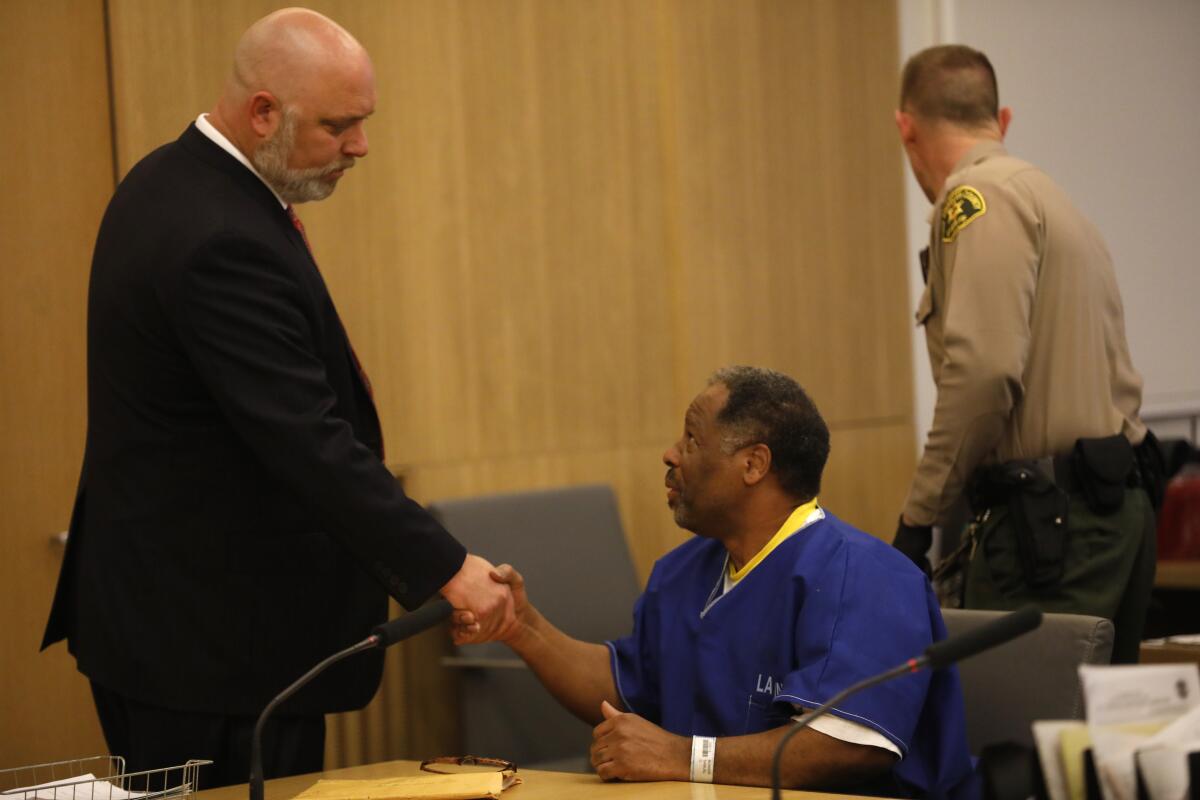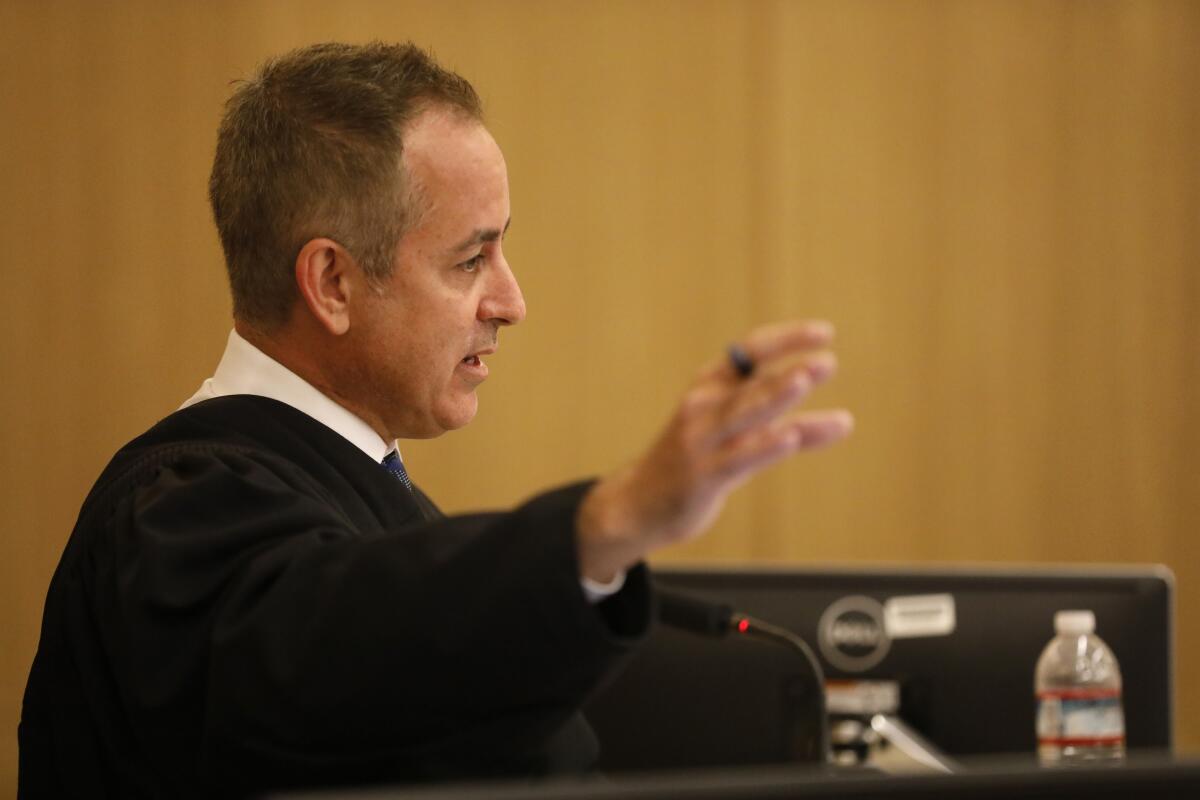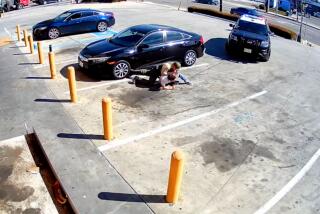A jailhouse informant’s lies put him in prison for 37 years. Now he’s free

- Share via
As soon as Samuel Bonner entered the Long Beach courtroom with his wrists chained to his waist, the judge made a simple, yet for Bonner, unprecedented, request: Could the bailiff please remove his shackles?
This is the moment, Bonner thought. This is it.
It was the closest thing to freedom he had felt in 37 years. The hour or so that followed was just as remarkable for the man who always insisted he was innocent of murder.
The hearing that day in July was spurred by the approval of California’s new felony murder law, which retroactively limits who can be charged with murder to those accused of actually killing or intending to kill. In L.A. County, Bonner and more than 1,600 others have sought relief, and about 10 convictions have been undone to date.
But the reprieve for Bonner that day went far beyond that. Superior Court Judge Daniel J. Lowenthal declined to resentence him and instead ordered him released, citing misconduct by a prosecutor who used a shady jailhouse informant. Besides the informant’s testimony, he said, there was little linking Bonner to the crime at all.
“That the death penalty was sought against someone based on testimony that was known to be false is horrifying and shocks the conscience,” the judge said.
◆

The saga began on Veterans Day 1982, when Leonard Polk was found inside his Long Beachapartment in a pool of blood, severely beaten with two bullets through the back of his head.
Bonner and an acquaintance, Watson Allison, were charged with killing Polk during a robbery, making both eligible for the death penalty if convicted.
At Bonner’s trial, the prosecutor at the time, Kurt Seifert, argued that Bonner was the gunman, despite a weak connection to the crime scene.
An undercover officer testified that he saw Bonner and Allison driving around, Bonner’s 1964 Ford rumbling and smoking, and thought they looked suspicious. The officer began to tail them, and when the car was idling at an intersection he observed a bicyclist leaning up against the car talking with Allison. The officer then saw Allison and the bicyclist, Polk, walk into a nearby apartment.
Later, a neighbor saw Allison making several trips in and out of the apartment carrying property including a TV set, and then driving off.
No one saw Bonner go inside Polk’s apartment. Authorities did find an envelope in his car addressed to Allison with Polk’s cross streets. A speaker found in Allison’s home — 11 days after the robbery — was marked by Bonner’s palm print. And a fuse found outside Polk’s apartment building matched fuses found in Bonner’s pocket.
The most conclusive link to Bonner came from the testimony of a key witness: A prolific jailhouse informant who claimed Bonner confessed to him that he shot Polk.
Before Bonner’s trial, the informant, Michael Hayes, appeared in court on his own murder charge. As part of a deal with prosecutors, he pleaded guilty to manslaughter and was sentenced to four years in state prison. The leniency was attributed to his cooperation in several serious cases, court documents show.
By then, one defendant in another murder case had already accused him of lying. During a preliminary hearing, Hayes testified that he saw the defendant shoot a man, then take his jewelry.
“You are lying,” the defendant blurted out, according to a transcript of the 1983 proceeding.
The judge tried to stop the defendant.
“He sits there and lie on me, just straight out lie on me like that. Why don’t he tell the truth?” the defendant said.
Hayes took the stand a few months later in Bonner’s trial, which involved just three days of testimony. Bonner’s lawyer, Ron Slick, who was known in legal circles as Dr. Death because so many of his clients ended up on death row, did not call a single witness in his defense.
Bonner was convicted of murder and robbery, but the jury concluded that he was not the shooter, so Seifert dropped the death penalty.
At Allison’s trial soon after, Seifert presented a separate panel of jurors with a different theory, in which Allison was the gunman and Bonner had a “relatively minor” role as the wheelman who never even entered the apartment. The prosecutor never brought up Bonner’s alleged confession.
Allison was convicted and sentenced to death.
In a deposition decades later in Allison’s habeas case, Seifert called his strategy — arguing at Allison’s trial that Bonner never set foot in Polk’s apartment — a “boo-boo” and “the big oops,” court documents show. A detective deposed around the same time said based on the evidence, he and his partner didn’t think Bonner killed Polk. He couldn’t remember if he formed that conclusion before or after Bonner’s trial, or if he relayed it to Seifert, court documents show.
Allison’s death sentence was eventually overturned and he was resentenced in 2012 to 25 years to life, according to the Department of Corrections and Rehabilitation. He will come up for parole again by January.
◆
Nineteen days after his verdict in 1983, Bonner wrote a letter to the judge saying he didn’t get a fair trial. He had wanted to tell his side of the story, he wrote, but his attorney didn’t let him testify.
Slick, the attorney, could not be reached for comment.
Bonner continued his fight for decades, losing his appeal and habeas petitions — once because the paperwork was filed late. He said he was found unsuitable for parole several times because he wouldn’t accept responsibility for the crime.

“I expressed my empathy for the family,” Bonner told The Times recently. “I can’t say I take back something I didn’t do.”
The repeated rejection left him numb, he said, but he never stopped believing that one day he’d be free.
In 2002, another case was overturned because Hayes lied about a jailhouse confession. As it turned out, Hayes had been trading information with authorities in Kentucky for years, but they cut him off as an informant because of repeated dishonesty.
Even still, Bonner’s case was never reopened.
A spokeswoman for the district attorney’s office said it had no record of receiving a conviction review request from Bonner and was not notified of the two habeas petitions he filed in Los Angeles County Superior Court in recent years. Both petitions were denied by Lowenthal, the spokeswoman said.
It wasn’t until January, when the new felony murder law went into effect, that Bonner had a fresh chance to fight. The law says that murder charges can be filed only against people who actually killed or were a major participant with reckless indifference to human life. Bonner filed a petition seeking relief, triggering a hearing.
Prosecutors opposed on constitutional grounds, as they have done in many other cases, arguing in court papers that the new law improperly changes voter-approved crime-fighting initiatives, including a proposition that set stricter penalties for murder and another that expanded the definition of first-degree murder. They also argued that because it’s retroactive, the law improperly reopens judgments that were final.
Some judges across the state have agreed, others have not. Five people have been released, one was resentenced and four others are awaiting resentencing, the district attorney’s office said. Nearly 650 petitions have been denied.
◆
A dozen or so of Bonner’s relatives showed up to his hearing last month in Long Beach, anxiously hoping for good news. His girlfriend said she noticed the judge looked over and smiled at them, which she thought was a positive sign. She took a deep breath.
“We’re really hoping,” Bonner’s sister said.

The judge started the hearing by saying he was going to do more than just address the constitutionality of the new law, and instead ran through the legal history of Bonner’s case. Lowenthal said that other than Hayes’ testimony, there was “scant evidence” that Bonner was involved in the crime at all. And Hayes’ lies, he said, began as soon as he took the stand, starting with his name.
“His name is Charles Jones,” Lowenthal said. “Everything thereafter appears to have been a lie as well.”
Lowenthal then recounted the inconsistencies: Hayes testified that Bonner said he shot Polk with a .357 magnum, but Polk was shot with a .22-caliber gun.
Hayes testified that Bonner told him he stole money, but the evidence shows no money was taken. Hayes testified that Bonner told him he woke Polk up and shot him, but the evidence shows Allison and Polk had just entered the apartment. Hayes testified Bonner told him that he entered Polk’s home alone, but Allison’s fingerprints were found inside. Hayes testified that Bonner told him he’d shot Polk once, but Polk had been shot twice.
Seifert, the original prosecutor, would admit decades later in a deposition that when he heard Hayes describe the gun as a .357 magnum, he knew the informant was lying. Seifert, now retired, could not be reached for comment for this article.
Lowenthal also said Seifert’s presentation of inconsistent theories at the two trials, with no new evidence, violated due process.
“It’s axiomatic that a prosecutor’s function is not merely to seek convictions but also to honor truth,” Lowenthal said. “Here, that did not happen.”
The district attorney’s office said there was no record that Seifert, whose deposition came eight years after he retired, communicated his concern to a supervisor. His deposition, conducted in Allison’s federal case in which the district attorney’s office wasn’t a party, did not trigger a review of Bonner’s case.
The prosecutor who appeared in court last month urged Lowenthal to give her office more time to evaluate the merits of Bonner’s petition, setting off a fiery exchange.
“You are considering releasing a convicted murderer,” said Deputy Dist. Atty. Evelis De Garmo, who did not try the case and was standing in for a colleague.
“Convicted because of prosecutorial misconduct,” Lowenthal replied.
De Garmo said she was not in a position to respond.
“If that has happened, we will be the first to concede, as we have in the past,” she said. “Justice is important to us, your honor, as you’ve indicated.”
“Apparently not in this case,” Lowenthal quipped.
De Garmo said she had come to court that day only prepared to address the constitutional argument.
“You have ambushed us, your honor, by setting it for one motion and hearing an entirely different motion, when we have no documentation about it.”
Ultimately, Lowenthal declined to resentence Bonner for the underlying robbery charge, citing “gross prosecutorial misconduct.”
Judges who have vacated felony murder convictions in other cases have resentenced defendants for whatever underlying offense led to the killing, whether it be a robbery, assault or other crime. In one recent case, a 25-years-to-life sentence for murder was reduced to four years for the remaining assault with a firearm charge.
Instead, Lowenthal dismissed both the murder and robbery charges, and urged the district attorney’s office to evaluate whether any other convictions were “procured in the same unscrupulous manner.”
De Garmo objected.
“Don’t interrupt me,” the judge said.
“That is very offensive,” she said.
“Don’t interrupt me or you are going to be removed from court,” he said.
A spokeswoman with the district attorney’s office said allegations of prosecutorial misconduct are taken “extremely seriously no matter how old the case,” and noted that the office is now reviewing Bonner’s case and other cases involving the jailhouse informant.
Lowenthal ordered Bonner released from custody. Bonner, who turned 57 this month, showed little emotion at the time. Behind him, his relatives cheered and applauded. Some wept; they all smiled. His sister and his girlfriend hugged each other tightly.
“Thank you, Jesus,” someone said.
Outside the courtroom, a niece FaceTimed one of Bonner’s sons.
“Your daddy’s coming home,” she told him.
Bonner was released from L.A. County Jail, where he had been held while awaiting his court appearances, on July 11, jail records show. He spent that day with his sisters in Long Beach, meeting nieces and nephews he never got to know. He visited his kids, including a daughter who was born just a month before he was locked up. She grew up speaking with him regularly over the phone and in letters, visiting when she could. So having him home was easy.
“We never lost touch,” said Tomeka Bonner, who turns 37 in October. “He’s a really good supporter mentally ... and spiritually; he just wasn’t around physically.”
Bonner is now continuing the schooling he started in prison. He’s enrolled in culinary courses and hopes to one day open a restaurant. He’s also interested in a trucking career, because “it’ll allow him to travel and be outdoors and see a lot of the things he wasn’t able to see,” Tomeka Bonner said.
“Whatever he wants to do I’m behind him 100%,” she said.
Bonner and his mom chat at least twice a day: Once to say good morning, again to say goodnight. Sometimes they just sit on the phone, not even exchanging words, because they can.
“I don’t have to wake up to the control of somebody else,” Bonner said. “I have more control of my life now, which is a good thing.”
More to Read
Sign up for Essential California
The most important California stories and recommendations in your inbox every morning.
You may occasionally receive promotional content from the Los Angeles Times.














